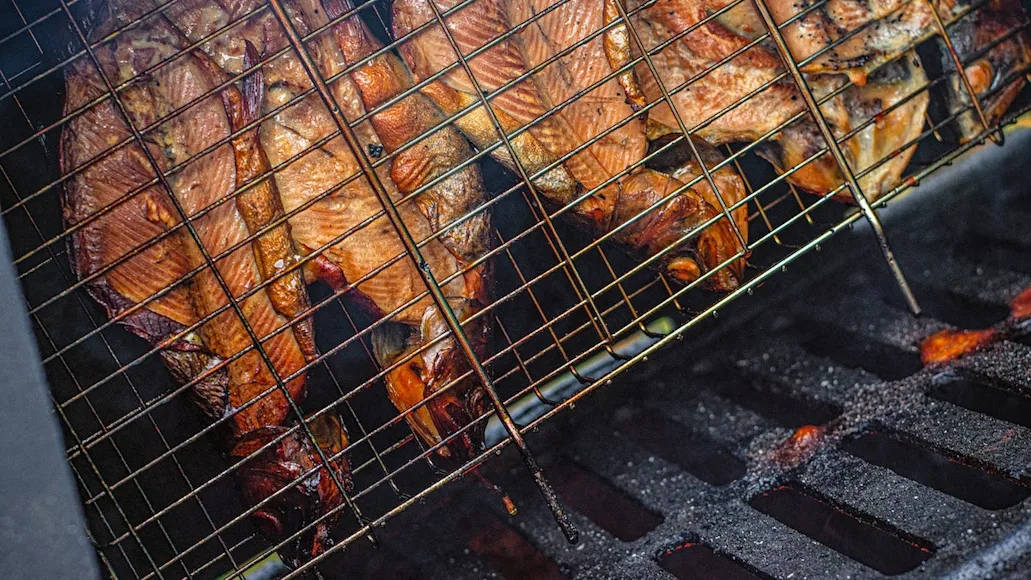Smoking fish is as old as fishing itself. Some techniques, and of course equipment, have evolved since our ancestors first tied a line to a stick, but some universal truths remain as relevant as ever. It isn’t complicated to smoke your own fish, but there are some mistakes you want to avoid. Whether you’re smoking saltwater or freshwater fish, if you want the best texture and flavor, keep the following in mind.
How to Smoke Fish: Table of Contents
What are the Two Basic Methods of Smoking Fish: Cold Smoked vs. Hot Smoked Fish
How to Choose the Best Kinds of Fish to Smoke
How to Choose the Best Kinds of Fish to Smoke
The Best Wood for Smoking Fish
The Best Kinds of Smokers for Smoking Fish
Fillets vs. Whole Fish
Dry Brine vs. Wet Brine for Smoking Fish
Basic Smoked Fish Recipes
How to Smoke Fish: Frequently Asked Questions
What are the Two Basic Methods of Smoking Fish: Cold Smoked vs. Hot Smoked Fish
Cold smoking requires a consistent low temperature (65-85 degrees F) to cure fish over several days, and without a lot of experience or the right equipment, there’s a bit of a learning curve. Hot smoking on the other hand is easy to do with pellet grills, electric smokers, and log burners. The tips below are for hot smoking fish. With smokers set around 160 degrees F, hot smoking doesn’t take as long as cold smoking and produces a fantastic finished product.
How to Choose the Best Kinds of Fish to Smoke
Bottom line: The fattier the fish, the better. Fat helps fish stay moist, and it absorbs more smoke, which results in more flavor. Some great fish to try smoking are trout, steelhead, salmon, tuna, swordfish, mackerel, and sturgeon.
You can smoke leaner fish like walleye and sunfish, but they’re usually better when cooked in other ways. If you are determined to smoke leaner fish regardless, follow the methods here but include an extra step for applying a thin coat of grapeseed oil to the fish before smoking. Doing so adds a very small amount of fat to the exterior, but more importantly, since grapeseed oil is a semi-drying oil, it will partially harden when exposed to air, forming another layer to help lean fish absorb flavor from the smoke.
The Best Wood for Smoking Fish
Choosing wood for smoking is largely based on personal preference, but most people who smoke fish agree that some woods are too “harsh” for the flavor of fish. Top fish smoking woods include alder, maple, pecan, apple, and even cherry—while you may want to stay away from hickory and mesquite unless it’s mixed with another wood. For me, a mesquite and cherry mix is likely the strongest wood mix I would ever use for smoking fish.
The Best Kinds of Smokers for Smoking Fish
Electric smokers, pellet grills, and log burners all work for smoking fish. In my experience, log burners offer a far more thorough smoke but come with a lower degree of control, and require more work to operate. For example, you’ll need to cut logs to a specific size (larger logs burn at lower temps for longer) instead of using chips, and you’ll want to cut off any bark because it adds harsh tones to the smoke.
Generally speaking, pellet grills and electric smokers are the easiest to use. But the smoke is far less concentrated and, in turn, the smoky flavor is less concentrated. After all, there is a reason world-famous smokehouses and barbecue pits have trailers of wooden logs delivered each day. Ultimately, though, the choice is yours.
Fillets vs. Whole Fish
It’s up to you whether you want to fillet a fish out or try smoking it whole. I prefer to smoke fish in the size I might serve. For example, if I have a limit of small to medium-sized trout, I’ll cut out their backbones, butterfly them, brine and smoke them whole, then serve. For a single, larger salmon, I might cut a fillet into 8-ounce pieces before brining and smoking.
Nevertheless, the sight of a whole fishing smoking is something special, and smoked skin from trout is also tasty. Do note that removing the backbone helps keep the fish opened up so smoke can penetrate the cavity. I like to use a grill mesh, in which I can situate the fish and then clamp the mesh shut to keep the fish spread open. You could also use a wooden skewer to pin open a fish and expose the fillets to more smoke.
Dry Brine vs. Wet Brine for Smoking Fish
There are those who argue there’s no such thing as a dry brine because a brine requires water, but I’d also argue salting meat pulls out moisture that then gets reabsorbed, creating what one might call an autonomous brine (as the moisture, thanks to salt, pools on top of meat). But this concept is also more true for red meat, so it is indeed possible a dry brine for fish is merely “salting the fish.”
A wet brine, by definition, is water with a high concentration of salt and includes other ingredients. To be clear, whether dry or wet, salt is the main component here, as it will penetrate meat while any other ingredients add more surface-level flavor. Salt binds to muscle fibers, which boosts flavor and helps retain moisture while cooking.
I’ve moved away from wet brines for most forms of cooking. Minerals in water (especially tap water) can denature protein (not in a good way, typically speaking) and affect flavor. And your tap water will vary from my tap water in terms of mineral content. If you’re determined to use a wet brine, I suggest buying spring water from the store and making sure to boil in a healthy amount of salt before adding a saltwater fish. Dry-salting a fish, is quicker and produces something called a pellicle on the exterior of the meat—which is a thin, sticky membrane to which smoke can adhere.
Whether wet brining or salting, you’ll need to rinse the salt off of the meat, pat off any moisture with a towel, then let the meat fully dry before smoking. (Wet fish creates a mushy texture and won’t absorb a lot of smoke.) To fully dry the fish, you can either leave it on a grate overnight in the fridge or place it under a fast-running fan in a cool (no more than 60 degrees), shaded place for an hour. The goal is a dry fish that’s a little bit sticky.
Read Next: The Secret Ingredient for Perfectly Cooked Fish
Basic Smoked Fish Recipes
As mentioned at the beginning, this article is meant to establish some guardrails but still allow you some room to improvise. Below are some basic brines and methods for smoking your favorite fish.
Wet brine ingredients:
1 gallon spring water
1/2 cup kosher salt
3/4 cup brown sugar
1/2 bulb fresh garlic, smashed
1/2 cup black peppercorns
Bring to a simmer and stir until the salt and sugar has dissolved. Cool in fridge and add your fish only once the brine has completely cooled. Brine 8- to 16-ounce cuts of fish or whole fish for 6-8 hours (a little longer for bigger cuts or whole fish), thoroughly rinse under cold water upon removal, pat dry, and allow the fish to fully dry before smoking at 160 degrees for 2-1/2 hours.
Dry brine / salt mix ingredients:
1 cup kosher salt
1/2 cup brown sugar
2 teaspoons paprika
2 teaspoon granulated garlic
2 teaspoons onion powder
1 tablespoon white pepper
Mix all ingredients in a non-active bin (glass or plastic) and add the fish flesh-side-down in 8-ounce pieces. Let it sit in the fridge for 1 hour. Flip the fish and let sit in the fridge for 1 more hour. Rinse off all salt under cold running water (this is a quick rinse but you want no granules or flakes left on the fish), pat dry, and allow the fish to dry either in the fridge overnight or under a fan (in a cool place) for 1 hour, until completely dry. Smoke at 160 degrees for 2 to 2-1/2 hours.
While smoking any fish, after allowing the fish to smoke for the first half hour, you can add a glaze of maple or agave syrup every half hour until the fish is done. I also like to mix in a tablespoon of pureed chipotle in adobo sauce for every 1 cup of maple or agave syrup and brush that on the fish.
FAQs
Q: Do you have to brine fish before smoking?
Smoking fish without brining it first can result in food poisoning. Fish smoked without brine will also not be as flavorful or moist as smoked fish that’s been brined first.
Q: Do you rinse fish after brining?
Yes. After either wet or dry brining, you’ll need to rinse the salt off of the fish, pat dry with a paper towel, and allow it to air dry completely before smoking.


